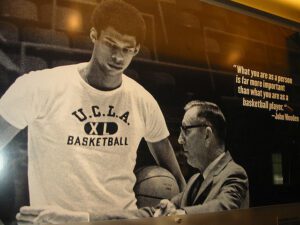Preventative Measures to Reduce Shoulder Injuries in Young Athletes
As coaches, we’ve all witnessed young, promising athletes suffer an athletically debilitating injury we know could have been prevented. Inward knee bend (valgus) when jump landing, early foot placement when running, and a forward weight shift when squatting are just some of the common high-injury movements.
A good coach can usually coach and teach these mistakes away, but there is one problematic issue that has wasted so many hours of training. I recall many sessions doing soft tissue work, stretches and then working to stabilize joints to no avail. Three to four weeks later, still no signs of improvement.
This enigma is poor posture.
Particularly, poor slumped forward posture (shoulders forward, forward head, humped upper back) worsened by school environments. Also known as Upper Crossed Syndrome, this posture increases the likelihood of shoulder injury due to reduced sub-acromial space. In other words, the connective tissue and rotator cuff muscles have less space to move and operate.
So what causes a poor, slumped posture? Sometimes it’s just the cards someone is dealt at birth. Sometimes it’s a lazy, sedentary lifestyle (e.g. texting, gaming, office job). But, for many young athletes who often play three to four sports a year, this is not always the case. The cause for many of these injuries is the athletes’ school environment.
Taking young athletes through a Functional Movement Screen (FMS) is a simple and reliable screen to effectively evaluate mobility. Other than the active straight leg raise (one of seven tests within the FMS), the shoulder mobility test is the second most commonly failed. Awareness of the following causes of poor posture resulting from the school environment can help coaches address the problem and program accordingly.
Cause #1: A heavy backpack
Seldom will you hear a young athlete with poor shoulder mobility deny that they wear a heavy backpack. Encouraging young athletes to walk with good posture or lighten their load doesn’t work. Their need for convenience will even outweigh their desire to lighten the load.
Middle and high school kids typically fit in anywhere from four to six classes a day which equals a lot of two-inch thick books and other essential classroom materials strapped on the back. For perspective, ‘The Essentials of Sport and Exercise Nutrition’ textbook weighs almost 4 pounds. So hypothetically, that is 16 to 24 pounds being put on and taken off intermittently throughout the day a dozen or so times; not exactly an ideal situation to maintain good posture.
Recommending a one-arm backpack (suitcase) carry or one-arm fireman carry to get the athlete to hold the backpack on one side of the body will strengthen the core muscles to prevent lateral flexion. However, trying to explain the direct positive impact on their body posture and rotator muscles won’t likely increase the possibility of compliance with this recommendation. Instead, an approach that appeals to their physical egos like telling them if they walk upright with the bag in one hand their abs will look better for the beach is more likely to appeal to middle to high school aged athletes.
Cause #2: The culture of high school weight rooms
A large number of young athletes don’t care if an exercise will make them better athletically because of a conflicting desire to bench more weight. Their focus is on other things like breaking a high school record or satisfying a desire to outperform another athlete in the weight room. Sure, their name will go up on a board somewhere and maybe they’ll earn bragging rights, but what the board does not communicate is whether the form was good or bad.
Moving heavy weight at the expense of form is a culture, and this culture is accepted in college weight rooms but equally so in high school weight rooms. Many high school weight rooms are run by head coaches double-timing as strength coaches who major in X and O’s and get a part time exercise science certificate on YouTube. The influence and rising popularity of CrossFit does not help. More coaches are going overhead just to go overhead.
Here’s the problem with the massive lift culture – auxiliary exercises like horizontal rows don’t need to be executed with heavy weight, the benefit comes in executing the exercise properly. In Paul Chek’s ‘Horizontal Back Training’, he explains how heavy rowing with the incomplete range of motion trains the nervous system to accept that range of motion as normal. So rather than achieve full scapula retraction, important for posture and shoulder health, we overwork small stabilizer muscles of the posterior shoulder (e.g. infraspinatus) making posture worse.
So what can we do? Young athletes are always going to want to one-up their buddies and go heavy, which is why having a culture of excellence in the weight room is so important. Strength Coach Mike Boyle says that weight room record boards reward genetics and nothing else. Sometimes lifting more weight is not beneficial to getting better on the field.
Trainers and coaches should be slow to hoot and holler over heavy weight being moved and be quick to reward and encourage form, especially excellent form under tension for extended periods of time, because this is true mental and physical discipline which always transfers out onto the field.
Cause #3: Scapula retraction
Combine a heavy back pack with partial rows and throw in an iPhone and you now have a scapula that has now ceased to function correctly, meaning the sequencing is off. The muscles surrounding the scapula don’t function as well because, as Chek explained, “there has been a rewiring of the nervous system.”
All young athletes (and not to mention most all general population athletes) need scapula retraction which is just the ability to squeeze the shoulder blades together. For many athletes the problem is not a painful shoulder – the shoulder is the symptom. The problem is a scapula that is constantly in an anterior position.
So what can we do? One of the best and most useful cues can be credited to Joel Sanders, an EXOS Performance Specialist. The cue some coaches use to get retraction is “squeeze the fruit” – Sanders uses the cue, “crush the walnut”. Using the cue “squeeze” helps athletes get some retraction but the second the cue “crush” enters the picture they pull their shoulder blades all the way together. This cue is recommended for all rowing exercises.
The school environment is a breeding ground for shoulder pathology that strength and conditioning exercise professionals can and should proactively confront. By taking the necessary steps to prevents this condition, you just might save a young athlete’s career.
Jason Williams is a doctoral assistant at the United States Sports Academy, owner of Williams Sports and Fitness, CSCS and XPS. You can follow his work on Facebook and Instagram.
How useful was this post?
Click on a star to rate it!
Average rating 0 / 5. Vote count: 0
No votes so far! Be the first to rate this post.



